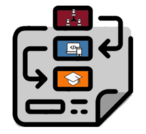
This short and sweet 5E lesson helps students explain the role of gravity in the formation of the solar system and in orbital motion (6.2c).
- Subject:
- Earth and Space Systems
- Material Type:
- Lesson
- Author:
- Melissa Bills
- Date Added:
- 03/11/2021

This short and sweet 5E lesson helps students explain the role of gravity in the formation of the solar system and in orbital motion (6.2c).

Video Description: What causes the phases of the Moon? From New Moon to Full Moon, the Earth-Sun-Moon system is responsible for the Moon’s changing phases. Learn more about rotation, revolution and this repeatable pattern. Video Length: 3:13. NASA eClipsTM is a suite of online student-centered, standards-based resources that support instruction by increasing STEM literacy in formal and nonformal settings. These free digital and downloadable resources inform and engage students through NASA-inspired, real-world connections.NASA eClips Our World videos (grades 3-5) help students understand the differences between science (the natural world) and engineering (the designed world). These video segments supplement elementary learning objectives not only in science, technology, engineering and mathematics, but also in reading, writing, visual and performing arts.

Video Description: Paul Chodas, Manager for NASA's Near Earth Object Program, explains Astronomical Units (AUs) and how this unit of measure helps simplify an understanding of distances within the solar system. To further simplify thinking about these vast distances, distances within the solar system are explained scaled to the size of a football field. Video Length: 2:25.NASA eClipsTM is a suite of online student-centered, standards-based resources that support instruction by increasing STEM literacy in formal and nonformal settings. These free digital and downloadable resources inform and engage students through NASA-inspired, real-world connections.NASA eClips Real World segments (grades 6-8) connect classroom mathematics to 21st Century careers and innovations. They are designed for students to develop an appreciation for mathematics through real-world problem solving.

Video Description: In addition to planets and their moons, there are many small bodies orbiting the Sun. How did these bodies form? Learn more about comets and asteroids and the role these play in our Solar System, as well as NASA's Rosetta and NEOWISE missions. Video Length: 3:09.NASA eClipsTM is a suite of online student-centered, standards-based resources that support instruction by increasing STEM literacy in formal and nonformal settings. These free digital and downloadable resources inform and engage students through NASA-inspired, real-world connections.NASA eClips Real World segments (grades 6-8) connect classroom mathematics to 21st Century careers and innovations. They are designed for students to develop an appreciation for mathematics through real-world problem solving.

In this lesson students will be able to identify that computers, like the solar system, complete predictable actions based on a set of variables. Students will learn about the solar system via Scratch. They will explore block coding and computational thinking practices as they utilize Scratch as a tool for creativity, expression and learning about the Solar System.